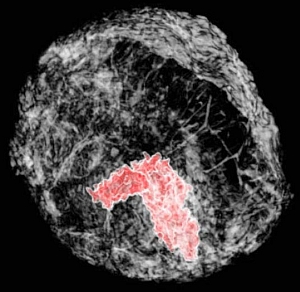Physicists and radiologists in the U.S. and Europe developed a new method for producing three-dimensional images of breast tissue with a lower dose of radiation than a mammogram. The team from University of California in Los Angeles, Ludwig Maximilians University in Munich and Garching, Germany, and European Synchrotron Radiation Facility in Grenoble, France describe their discovery online in the journal Proceedings of the National Academy of Sciences (paid subscription required).
The new technique aims to provide higher resolution images of breast tissue to spot earlier and more accurate signs of tumors. The most common breast cancer screening method used today is dual-view digital mammography, which according to UCLA’s senior author physicist Jianwei Miao, “can explain why 10 to 20 percent of breast tumors are not detectable on mammograms.”
Computed tomography (CT) X-ray scans can provide a three-dimensional image of breast tissue, but requires a higher dose of radiation than a mammogram. “It is very important to keep the dose low to prevent damage to this sensitive tissue during screening,” Miao adds.
To meet this problem, Miao and colleagues tried a different imaging technique, phase contrast tomography that provides soft-tissue imaging without the use of stain injections or high radiation, which enabled the researchers to take multiple X-ray images of a human breast from multiple angles. Phase contrast X-ray tomography measures the difference in the way an X-ray oscillates through normal tissue rather than through slightly denser tissue like a tumor or bone. This technique captures the differences in oscillation between normal and denser diseased tissue, with each image made using this technique contributing to the overall 3-D picture.
The team then reconstructed 512 of these phase contrast tomography images into a high-quality 3-D composite. To assemble the 512 images, the team used an algorithm called equally sloped tomography developed by Miao for imaging nanoparticles, published earlier this year. The result was 3-D images of breast tissue two to three times sharper than those made using today’s hospital CT scanners, and with a lower dose of X-rays than a mammogram. In independent evaluations, five radiologists from Ludwig Maximilians University ranked these images as having higher sharpness, contrast, and overall image quality than 3-D images of breast tissue created using other standard methods.
The equally sloped tomography algorithm requires sophisticated software and and high-powered computers to assemble the components into a single 3-D image. While Miao and colleagues were able to reduce the number of images needed to assemble the composite image, the technique still needs further development before it is ready for clinical use, according to co-senior author Alberto Bravin of the European Synchrotron Radiation Facility.
“While we can demonstrate the power of our technology, the X-ray source must come from a small enough device for it to become commonly used for breast cancer screening,” says Bravin. “Once this hurdle is cleared, our research is poised to make a big impact on society.”
Read more:
- CT Image Analytics Adapted for COPD Diagnosis
- Low-Dose, High-Rez CT Scanning Technique Developed
- Imaging Technique Highlights Cardiac Arrest Candidates
- 4D Lung Imaging Technology Developed
* * *


 RSS - Posts
RSS - Posts
[…] 3-D, Low-Radiation Breast Cancer Imaging Technique Developed […]
[…] 3-D, Low-Radiation Breast Cancer Imaging Technique Developed […]